Dawn was just about to break as the OH and I walked to the reception area of Kanha Earth Lodge from our cottage, bundled in warm clothes, ready for the safari. At 5.30 AM, it was foggy and a tad cold, but the much-palpable enthusiasm of our group ensured that we did not mind it. The topic of discussion – would we or would we not spot a Royal Bengal tiger, which the forests of Kanha were famous for? After fortifying ourselves with cups of hot coffee, we settled into the Gypsy that had been arranged for us – the OH and I, another guest couple, and our nature guide, Mahesh, who would be driving the vehicle.
We drove past the fields and mud huts of Narna village for about 10 minutes before we reached the Kisli zone of the Kanha National Park. Our ID proofs were verified, post which Surinder, an official of the Forest Department hopped into our vehicle, too. As per government regulations, he would be accompanying us on our foray into the forest. We exchanged pleasantries and names, and soon enough, were driving into the beautiful forest zone that is Kisli.

There weren’t many other vehicles around at the time, and we were thankful for that. The air was pure and smelled wonderful, as only the air in a forest can, and the OH and I breathed in huge gulps of it. Bird calls and the occasional grunt of an animal were the only sounds that we could hear. Maintaining the speed limit, Mahesh drove into the forest, and I gasped as I noticed how pretty it was. Green, green, green sal trees were all around us, standing like sentinels to protect those who inhabited the area around them. We learnt that sal trees are evergreen – as soon as they shed their leaves, new leaves sprout, causing them to remain green throughout the year – resulting in the woods looking exactly the same, irrespective of the time of year.
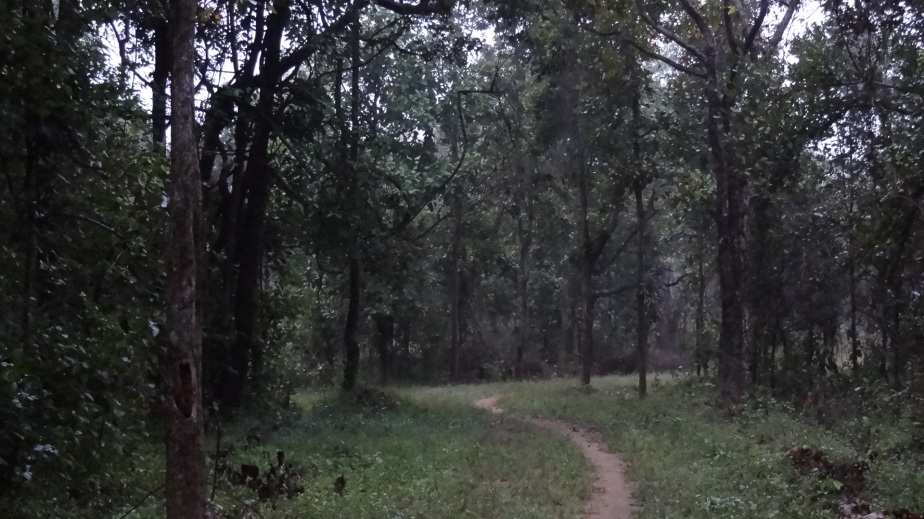
Little by little, as we inched deeper into the forest, I could clearly see why Rudyard Kipling was so inspired by these forests (yes, the Kanha forests were what inspired the author to write the famous Jungle Book). No sensitive soul could remain untouched by the prettiness of the forest that we were seeing slowly unfold around us.

Mahesh and Surinder kept a lookout for any animals hiding in the undergrowth or drinking water from the many small waterbodies that we passed, while we were busy taking photographs of the jungle. Very soon, we spotted our first wildlife of the day – a pair of jackals, frolicking happily in a clearing, seemingly having fun.

As we went deeper into the forest, herds and herds and herds of spotted deer met us. We were amazed at the sheer number of deer that reside in the Park. Often, our vehicle would stop to allow four or five of them to cross the pathway that we were moving on, to get into a clearing or waterbody on the other side. Such nimble, graceful creatures!
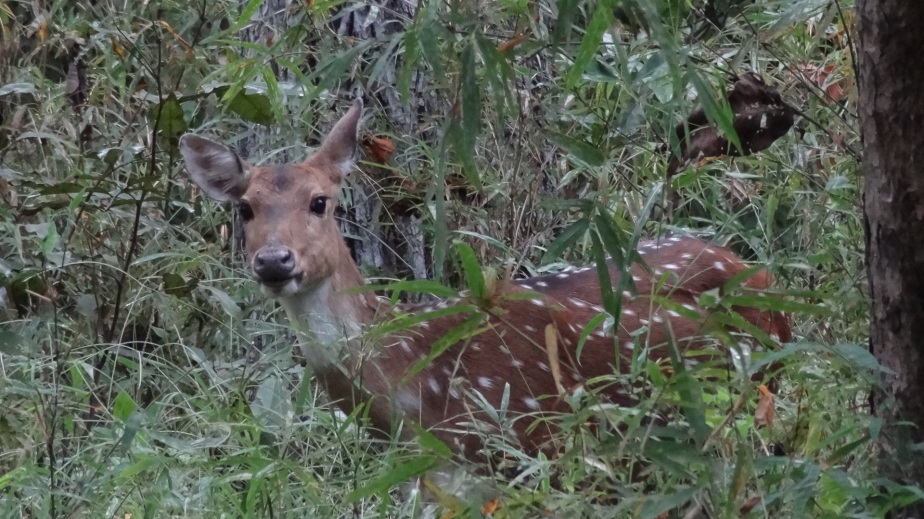
Mahesh and Surinder pointed out a number of small insects and birds to us guests, all happy to click away. It is butterfly-breeding season now, we were told, which explained the huge number of butterflies of different sizes and colours fluttering gaily here and there.

We came upon a camp of elephants, which were being bathed and fitted with seats. These elephants are used for patrolling by the Forest Department, we were told. We were awed to see the camaraderie that the men of the Department shared with the elephants. The animals followed every single command that these men delivered in Hindi. We were even more stunned, later, to see the elephants patrolling the forest, perfectly following the instructions that the mahouts tapped out on their backs using their feet! What a sight that was – I wish I had taken a video!

Mahesh told us to keep an eye out for Munna, the star tiger of the Park, a big male cat who is quite used to tourists and poses beautifully for their cameras. We kept praying for Munna to appear in front of us, as we moved deeper into the jungle, spotting more insects, birds and small animals on the way.


We encountered a very hungry wild boar, so busy foraging for food (read roots of plants) that it did not give us more than a cursory glance as we stopped right beside it and clicked pictures to our heart’s content.
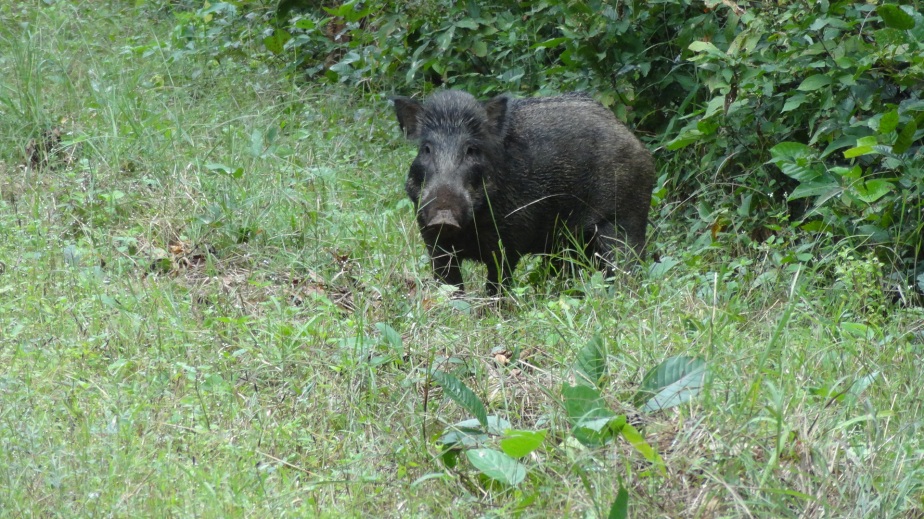
We spotted a lot of black-faced langoors, as usual, up to mischief, swinging from overhanging branches of trees, pulling out roots of plants and eating the bark of trees. Some gave us curious glances as we passed by.

I was thrilled to spot a peafowl in the wild. The brilliant blue of its neck caught my attention.
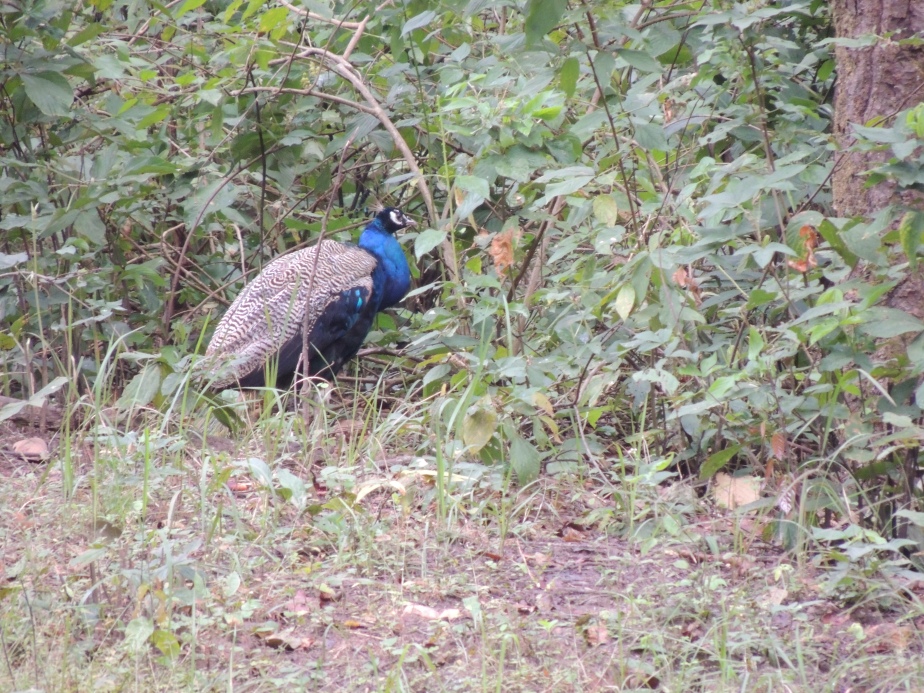
A herd of sambar deer jumped out in front of our vehicle, causing us to pull to an abrupt halt. They wanted to get to the opposite side to have their fill of water from a waterbody there. In the process, we got some great shots of them.

We tried to muffle our shrieks as the huge webs of equally huge spiders almost touched us, as we drove farther on. I am not exaggerating. Take a look for yourself – can you imagine what it is like to be whacked in the face by THAT? 😦

Surinder pointed us towards a tall tree in the distance and asked us to use our zoom lenses to get a glimpse of the bird perching atop it. It was a Malabar pied hornbill, we were told, quite a rare sighting!
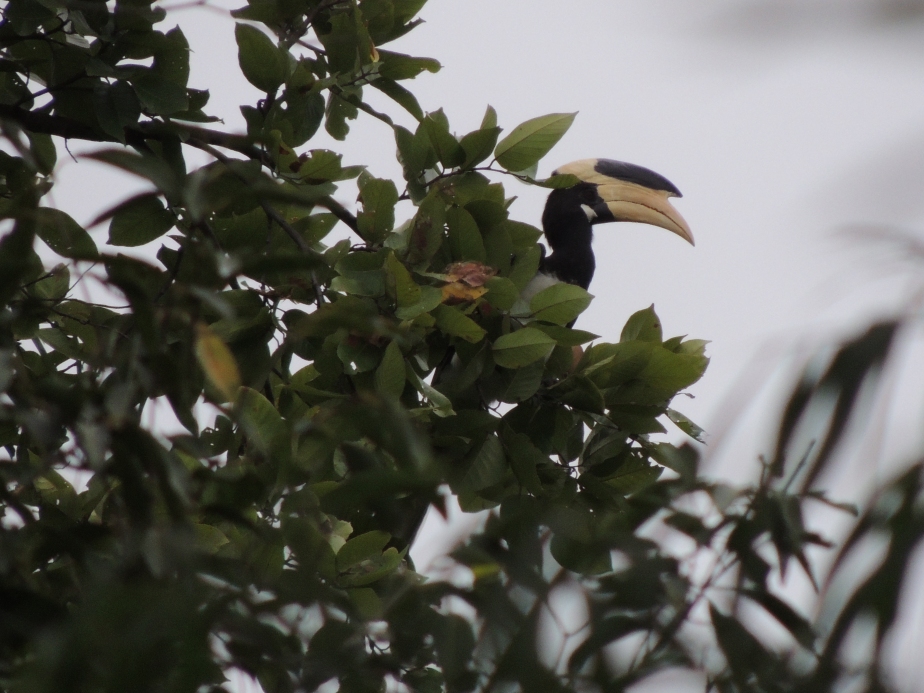
All this was okay, but there was no sight of Munna or any of his counterparts, much to our disappointment. Plus, half of the time allotted for our safari was over. We headed out of the Park to the canteen, for breakfast. The lodge staff had painstakingly packed sumptuous breakfast hampers for each one of us, including fruits, sandwiches, cookies, tea/coffee and muffins. After eating our fill (carefully guarding it from the many mischievous langoors around), we drove back into the forest for the last leg of the safari. On our way in, we stopped to say hello to a brown fish owl that had found a comfy resting place inside a little hollow in a big tree. We bended this way and that to take photographs of the well-camouflaged owl, and then set off again.
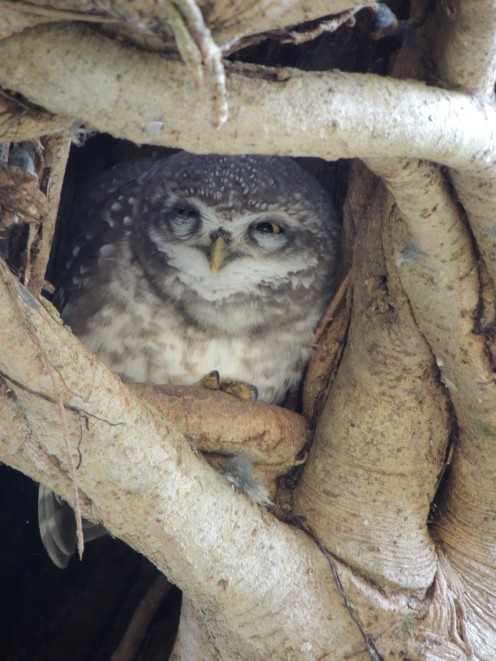
It was when we again drove into the heart of the forest that the real excitement began. We began to hear the frenzied cries of monkeys and sambar deers and the calls of a couple of birds. Mahesh told us that these sounds indicated that a tiger was nearby. We looked around, drove around a bit more, spotted some tiger pug marks and even some tiger dung, but no tiger.
Mahesh suddenly stopped the vehicle when we came to a big bush. All our mouths collectively dropped open when he told us there was a tiger inside it. There was tall grass growing outside the bush, which itself was pretty dense, and we could not spot a thing. In fact, we would have passed right by the bush, without noticing anything untoward, if he had not stopped. The expression on Mahesh’s face told us he was not kidding. He pointed us to a tiny hole in between two tall fronds of grass and we could, indeed, see some movement! I think these nature guides have some sort of instinct that enables them to zone in on the exact spot where one can find an animal. Mahesh proved that more than once. Anyways, we did see a large shape inside the bush, and the lifting of a paw now and then, but not more than that. We learnt that it was a large male tiger, not Munna, which was apparently people- and camera-shy. There was nothing we could do, except wait. We waited and waited and waited, till the time for our safari almost ran out. Then, tiger sighting or no sighting, we HAD to get out of the Park.
No amount of zooming in of our lenses could get a picture of the tiger. All we managed to capture were the bush and the grass surrounding it. Huh! That is how we ended up with absolutely no pictures of our near-glimpse of the tiger.
We did not spot any more animals, other than lots more deer and a cute rooster and hen, on our way back.
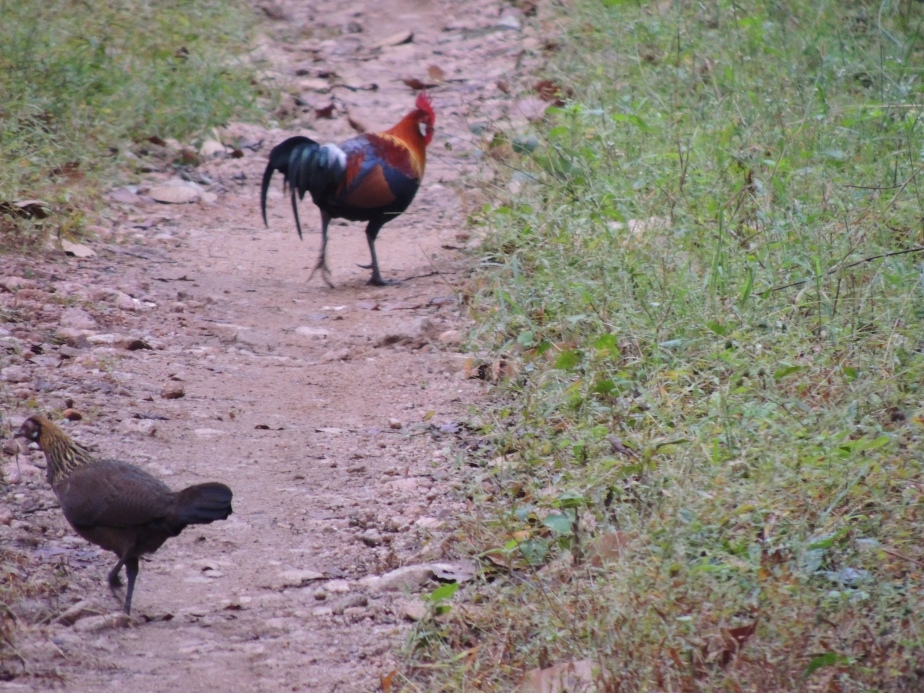
By then, we had fallen in love with the jungle some more, and the disappointment had entirely disappeared. We realised that irrespective of whether we see a tiger or not, the drive through such a lovely forest is an experience in itself. We would happily do it all over again.
***********************
This is the story of the safari we went on on one of the days of our stay at the Kanha Earth Lodge. We managed one more safari, too, in which we spotted nothing but some wild boar, more deer and some roosters and hens.
For those interested in the safari, the Park remains closed from July to October, coinciding with the monsoons and the tiger breeding season. Original and valid ID proofs are required to undertake the safari, which are thoroughly verified by Forest Department officials. One can opt for either a morning safari or an evening one. Though the Park is a pleasure to drive in in any season, tiger spotting enthusiasts are advised to plan a visit in the summer months of April and May. Chances of spotting tigers are quite high during these two months, considering that the heat inside the jungles drives the tigers out of bushes and near waterbodies to slake their thirst.
Beautiful pictures and awesome share. Kanha is one of the best wildlife destinations in the World to experience the beauty of nature and wildlife. Last time we have visited over there at stayed at Singinawa Jungle Lodge and it was a great experience to see the leopard, barasingha, wild pig, jackals and other flora and fauna including beautiful landscape. Your post makes me same experience like you. Thanks. 🙂
LikeLike
@Partha
Thank you so much. Welcome here.
LikeLike
A nice post.
Probably a bit late, but just thought I’d let you know that it’s not a Brown fish owl, but a “Little” Owl. Brown fish owls usually have shaggy eyebrows.
LikeLike
@Matt
Hey there! Thanks for writing in, and for the explanation. Really appreciate it. 🙂
LikeLike
The bird that you could not identify is a cormorant! 😀
Wow… the place looks lovely! You went in October it seems and hence a lot more green then perhaps when I visit in March… but that should mean a drier forest and perhaps more visibility 😀
Sigh I can’t wait for March! 😀
Loved the narrative and the pictures! 😀 Loved the part when the tiger almost appeared… I have had many many close encounters for many years but never managed to spot a tiger in the wild till last year and I have been safari-ing since quite a long time! 😀
LikeLike
@Hitchy
Thank you, Hitchy, for the ID and for the kind words. 🙂
Yes, visibility is definitely more in March-April, we were told. Vegetation is thinner, and hence, you will be able to spot animals more easily. Moreover, there are good chances of spotting animals near water bodies in the summer months. When we went, it was raining, and visibility was comparatively lower.
LikeLike
Great post! Love the “howzzat’ 🙂
LikeLike
@Dreamzandclouds
He he. Thank you. 🙂
LikeLike
It is such a different experience when you are so close to nature. I can feel it by just seeing the pics.
LikeLike
@Amit
Yes, that is true. It is such a different experience from our routine lives. It has a different rhythm, a raw beauty all its own.
LikeLike
Btw, can’t seem to find your “about me” page or even your name on the blog!
LikeLike
@Shivya
Oops! Just used a new template, and didn’t realise that my ‘About me’ and ‘Contact me’ pages were not visible. Have rectified it now.
Thanks for letting me know! 🙂
LikeLike
Your descriptions and the pictures brought back so many memories! Looks like we just missed each other in Kanha 🙂
LikeLike
@Shivya
Yes, maybe we passed each other and never knew!
Thank you. 🙂
LikeLike
The pictures !!! They are breathtaking !
I was just staring at that owl picture ! Wow, it looks like a lovely place..definitely going there once
LikeLike
@Ria
It is a beautiful place, indeed, Ria. An experience worth having at least once in your lifetime.
LikeLike
Loved the owlie snap and the chitte picture! 🙂 I could almost feel the same excitement when I was reading about the probable tiger spotting.It looks like some serious effort has gone into preserving the ecosystem.Lovely post 😀
LikeLike
@Vidya
Thank you, Vidya! 🙂
I was wondering what ‘chitte’ was, till the OH enlightened me.
Yes, a lot of efforts are being undertaken to preserve our forests, that I can vouch for. I saw that first-hand. I will, hopefully, do a post on that soon.
LikeLike
Tiger or no tiger, these photos are truly remarkable, and what an adventure! The photo of the brown fish owl is particularly incredible. You got close to your subject, and the photo is both artistic and natural. Your pictures make me want to be out in nature where animals are, and they also make me wish I were a nature photographer.
LikeLike
@Suko
Thank you so much for the kind words, Suko. 🙂
LikeLike
What a pleasure to the eyes!!! Lovely photographs and more than that, a lovely post too 🙂
LikeLike
@Greenboochi
Thank you so much, GB! 🙂
LikeLike
Ah! what a post..sigh! I really save so much money in travelling you know..just reading your writing, transports me there!
LikeLike
@R’s Mom
He he. You SHOULD go on a wildlife safari with the brat sometime, you know? It’s an experience in itself, tiger sighting or not.
LikeLike
This was a very nice account TGND. I am reminded of our Bandipur trip and Mudumalai hills trip a coupel of months back, that I will be documenting on my blog too. We were overjoyed to be undertaking this awesome trip and I just the experience of being in a jungle was goosebump-inducing and the cold weather added to it 🙂
Have you been to Bandipur? The elephants are so cute.
LikeLike
@Kismitoffeebar
We have passed through Bandipur en route to Ooty a couple of times, but have never really been on a wildlife safari there. Now, I am ashamed. 😦
I always love passing through the forests of Bandipur and, as you say, the cold weather only makes the experience more loveable. I should do the safari there sometime. We have, however, spotted animals many times just like that, while passing by, from our car.
Thank you. 🙂
LikeLike
What is not to love? And the same was visible in every word that you wrote 🙂
LikeLike
@Comfy
Thank you, Comfy! 🙂
LikeLike
That butterfly shot is very special.
I didn’t realise these were *the* jungles in The Jungle Book. Now I want to see them for myself!
Just sorry you didn’t manage to get a better picture of the Tiger. Then again, sometimes it’s easier to remember things that weren’t documented and then tucked away.
LikeLike
@Bronwyn Joy
Thank you. 🙂
We are sorry we couldn’t see the tiger up close, but then, we have a good reason to go back to Kanha again. 😀
LikeLike
Nice post! Awesome pics too 🙂 I wrote about our visit to Kanha as well… http://kanwalkwilltravel.wordpress.com/2013/07/12/in-search-of-the-royal-bengal-tiger/ … we got lucky with a few tiger spottings. When they are in the bushes they are totally camouflaged!
LikeLike
@IKan
Oh wow! Off to read your post now. 🙂
LikeLike